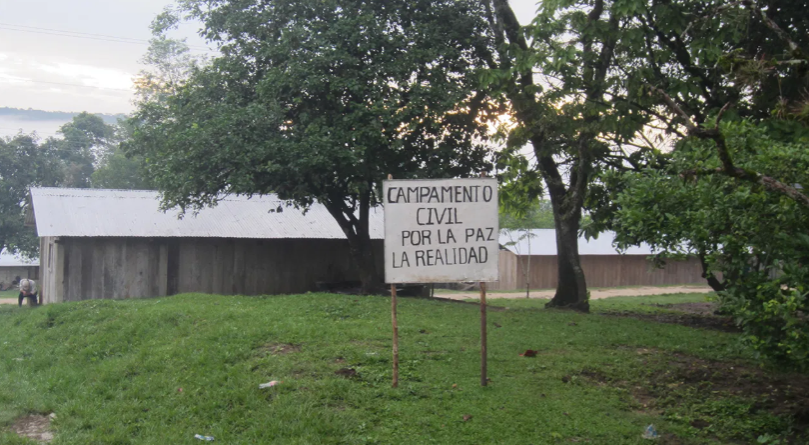
Europeans came to live in these solidarity encampments in Zapatista communities in the early years of the struggle. Photo: Frayba
By Luís Hernández Navarro
The history of the colonization of the New World and of capitalist expansion follows the Atlantic route. Across the ocean arrived the first colonizers and priests to America, accompanied by their weapons and their faith. Inseparable, the cross and the sword sailed the seas, followed by slaves and merchandise. Transported by winds and maritime currents, the ships returned to Europe loaded with the fruits of their looting and plunder.
This May 3rd, the Day of Santa Cruz, Chan Santa Cruz, the name given to the sanctuary and autonomous Mayan government kept alive for half a century by rebel indigenous, the roles will be reversed. On this day, also across the Atlantic, the Zapatista boat, La Montaña, will launch from Isla Mujeres in the direction of the Puerto Vigo, Spain to meet its comrades and a multifaceted series of figures and social movements. The ancient route of the Conquest will be the way by which the emancipator expedition christened by the EZLN as the Journey for Life arrives in Europe.
The exciting encounter between insubordinates, outlaws, and protagonists of anticapitalist popular revolts on the two continents, narrated by Peter Linebaugh and Marcus Redinker, in their marvelous book The Many-Headed Hydra: Sailors, Slaves and Commoners and the Hidden History of the Revolutionary Atlantic, will be re-edited, now in reverse. The sailors — write Linebaugh and Redinker — brought to Europe stories that told of the alternative societies of America. Along the way, they linked the primitive communism of the New World with the plebeian communism of the Old World.
The scope the initiative can only be understood in full if one puts aside the distraction of assuming that all is resolved in the State and by the State. The current struggles, taken in their globality, instead of accepting the homogeneity of the State, of capitalism, of technology, lead to differences. Nostalgia for the Cortina de Nopal 1 (Prickly Pear Curtain) has nothing to do with the left. Emancipatory struggles have always been internationalist.
Certainly — as English social historian Edward P. Thompson stated — to try to influence the course of history through movements from below is a thankless task, and terribly time-consuming. But, in the long-run, it is one of the few honorable places to be.
In its European phase, the maritime delegation of the EZLN, which other delegates, arriving by air, will join, will visit more than 30 countries. And there it will meet with thousands of activists that since 1994 have visited and lived for periods in the autonomous Zapatista communities. They are going to see old alter-globalist acquaintances, that today (as yesterday) are tireless fighters against facism, generous organizers of migrants, vital builders of new forms of urban coexistence, brave trade unionists in a precarious labor world, seasoned topplers of statues of slave traders and colonialists (https://bit.ly/2PluaBF).
The connections between the Zapatistas and their European interlocutors, enduring and surprisingly vital, despite the passage of years, have been ignored or passed unnoticed by those that see the world from above. However, they have profoundly branded the dynamic of the antisystemic struggles. Although it formally is, Brussels is no longer the capital of the European Union. On the map of resistances, Athens, Genoa, Gibraltar and the centers where migrants arrive have changed the map of resistances, and take its place.
Between them is a long history of cooperation, solidarity from below, shared language, reclaiming and reinventing of the commons; a WE. They have crafted a horizon that is collectivist, anti-authoritarian and egalitarian. Their alternative ways of life are profoundly intertwined. They have forged adversity-proof bonds of friendship, affection, and communion. They are a community united by ideas, sentiments and common experiences. There is among them, albeit incipient, a jointly-created global destiny (https://bit.ly/3gDMd14).
The Zapatista journey can be interpreted as an exodus from the organizational framework in which orthodoxies are institutionalized. The rebels of both continents share the fact that heresies were born of the peripheries. As the French philosopher Henri Lefebre indicated, the peripheral is situated at times, in the center, or it is the key to reach it. Only the peripheral reaches the conscience and the knowledge of the centers. The peripheral conscience, methodically directed — he says — allows one to reach the knowledge of the center and of globality.
Far afield from the WaltDisneyization of the past, with the recognition of the memories of the historical peoples of the American continent as a pledge, radically confronted with the persistence of colonial arrogance, far away from the paralyzing victimization that does not break with the logic of power, they have launched another politics for life, that is not subject to the watch of the businesses nor to the calendar of those from above. Their proposal, that avoids repeating itself, and emerges from earthly realities, evades the times of the economy and the moments of representation.
In the hour of the word, from the Lacandón to the world, about to raise anchors in Isla Mujeres to sail the waters of the Atlantic, the Zapatistas, like sailors will not speak softly, because as we know, the sea speaks loudly.
This piece was published in LaJornada on April 27, 2021. https://www.jornada.com.mx/2021/04/27/opinion/016a1pol This English interpretation has been re-published by Schools for Chiapas.
